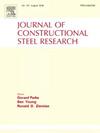Experimental and theoretical investigation of the high-cycle fatigue failure mechanism of M24 high-strength bolts
IF 4
2区 工程技术
Q1 CONSTRUCTION & BUILDING TECHNOLOGY
引用次数: 0
Abstract
This study delves into the fatigue failure mechanisms and pivotal fatigue performance parameters of grade 10.9 M24 high-strength bolts, critical components in steel structures. We executed 15 constant-amplitude axial tension high-cycle fatigue tests at a stress ratio of 0.8, complemented by five fatigue crack growth rate tests and three fracture toughness assessments, all utilizing material identical to that of the bolts. The investigation encompassed an analysis of fatigue fracture surface characteristics of representative bolt specimens and a numerical simulation of the bolts' fatigue crack growth life. The study's findings reveal that the S-N curve and constant-amplitude fatigue formula for M24 high-strength bolts have been successfully calibrated. The fatigue performance key parameters—crack growth rate C = 1.26 × 10−12, exponent m = 3.35, and fracture toughness KIC = 106.67 MPa·m1/2—were precisely determined. The initial crack morphology characteristics (a/c) and the stress ratio during loading were found to significantly influence the fatigue crack growth life, whereas the stress amplitude's effect on the proportion of the crack growth life within the total life was irregular. Theoretical calculations and numerical simulations, grounded on the fatigue performance parameters, indicate that the crack growth life constitutes an average of 10.13 % to 25.82 % of the total life span, with the initiation phase substantially outweighing the propagation phase, contributing to over 70 % of the overall life.

本研究深入探讨了钢结构的关键部件 10.9 M24 级高强度螺栓的疲劳失效机理和关键疲劳性能参数。我们在应力比为 0.8 的条件下进行了 15 次恒幅轴向拉伸高循环疲劳试验,同时还进行了 5 次疲劳裂纹生长率试验和 3 次断裂韧性评估,所有试验均采用与螺栓相同的材料。调查包括对代表性螺栓试样的疲劳断裂表面特征进行分析,以及对螺栓的疲劳裂纹增长寿命进行数值模拟。研究结果表明,M24 高强度螺栓的 S-N 曲线和恒幅疲劳公式已成功校准。疲劳性能关键参数--裂纹增长速率 C = 1.26 × 10-12、指数 m = 3.35 和断裂韧性 KIC = 106.67 MPa-m1/2 --均已精确确定。研究发现,初始裂纹形态特征(a/c)和加载过程中的应力比对疲劳裂纹增长寿命有显著影响,而应力振幅对裂纹增长寿命在总寿命中所占比例的影响则不规则。以疲劳性能参数为基础的理论计算和数值模拟表明,裂纹增长寿命平均占总寿命的 10.13% 至 25.82%,其中起始阶段大大超过扩展阶段,占总寿命的 70% 以上。
本文章由计算机程序翻译,如有差异,请以英文原文为准。
求助全文
约1分钟内获得全文
求助全文
来源期刊

Journal of Constructional Steel Research
工程技术-工程:土木
CiteScore
7.90
自引率
19.50%
发文量
550
审稿时长
46 days
期刊介绍:
The Journal of Constructional Steel Research provides an international forum for the presentation and discussion of the latest developments in structural steel research and their applications. It is aimed not only at researchers but also at those likely to be most affected by research results, i.e. designers and fabricators. Original papers of a high standard dealing with all aspects of steel research including theoretical and experimental research on elements, assemblages, connection and material properties are considered for publication.
 求助内容:
求助内容: 应助结果提醒方式:
应助结果提醒方式:


